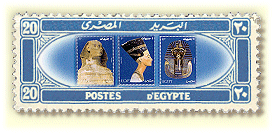

Egypt's first three booklets of stamps were produced by Thomas De La Rue & Co. Ltd of London, utilising stamps of the then current issue with star and crescent watermark. All booklets had interleaving of paraffin waxed paper, commonly used in hot countries to prevent stamps adhering to each other. The first booklet, containing four panes each of six 5-millième rose stamps (120 millièmes), was put on sale on 1st January 1903, at 121 millièmes but was not popular, due no doubt to the one millième surcharge and a Postal Circular of 16th June 1911 stated that "starting the 1st July following, the booklets containing 24 stamps of 5 millièmes will be sold at 120 millièmes instead of 121 millièmes". The second booklet soon followed on 1st July 1903. 4 panes of 6 x 3 millièmes yellow, two staples at left and printed black on blue. The selling price of this booklet (73 millièmes) seemed to be just as unpopular, but in this case the booklets were eventually distributed to Post Offices to be sold over the counter as loose stamps according to a Postal Circular dated 15th October 1907. On 1st July 1911 De La Rue produced the third booklet, also of four panes of five millièmes. It was sold at face value, 120 millièmes. From 1921 the printing of Egyptian postage stamps was carried out by Harrison & Sons Ltd of London and from this date a new watermark, the multiple star and crescent, came into use. The fourth booklet was produced on 12th June 1921 with four panes 6 x 5 millièmes; two staples at left, printed black on pink, and sold at 120 millièmes. This booklet introduced advertisements on the five interleaving panes, printed each side in English, French or Arabic. Advertisements were also printed on both sides of the back cover and inside the front cover, with details of the booklet make-up and price printed in English and Arabic on the outer front cover. From 1926 Egyptian stamps were printed by the Egyptian State Survey Department and from 1926 to 1943 booklets were manufactured from sheets of 120 stamps comprising two panes of 60 (each 6 x 10) separated by a vertical plain gutter the width of a normal stamp. By the time of the revolution seventeen booklets had been produced. The last Farouk issue booklets of 1952 were withdrawn from sale on the abdication and used by the Parcels Office of Cairo Central Post Office before these stamps became obsolete. A booklet based on the first republican stamps was issued in 1954 consisting of 4 panes 6 x 10 millièmes, stitched left or right and printed black on pink, price 240 millièmes. Since then no further booklets have been produced using standard definitives. However in 2004 a new booklet appeared titled "Discover the Treasures of Egypt in Stamps" and consisting of 30 stamps. Its probable issue date is January 22; the booklet was offered by the Philatelic Sales Office at £E80 but the face value of the stamps is £E51.95. The booklet was originally thought to be a "souvenir issue" intended for tourists, with the stamps having no postal validity. Covers have been seen with these stamps, some sent by ESC members, and have not suffered any penalty. They are also accepted by major catalogues and by the UPU as legitimate postal stamps. This booklet then should be thought of as booklet 20. Although printed in large quantities, booklets were not seen as collectable in the early days, resulting in some scarcity. Interest in earnest began in the Sixties and now those few that do make it to auction are fiercely contested. 
|
|
|